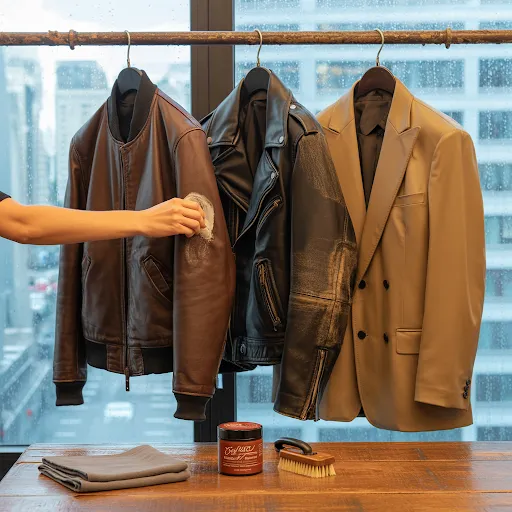Can Leather Jackets Get Wet? Here’s What Actually Happens

Table of Contents
Rain and leather jackets usually don’t exactly pair well. So if you ever get caught in a downpour while wearing your favorite leather piece, you might wonder: can leather jackets get wet? The answer is yes, but it’s how you treat them afterward that really matters.
Improper drying can damage the shape, texture, and durability of the leather. Here’s exactly what you need to know if you find yourself facing rainy skies in leather.
What to Do When Your Jacket Gets Wet
Here’s a quick checklist:
- Take it off and lay it flat (avoid bunching it up).
- Pat off excess moisture.
- Hang on a shaped hanger.
- Air dry slowly, naturally.
- Condition when fully dry.
If the jacket starts to look or feel stiff, apply a second coat of conditioner or take it to a pro cleaner who knows how to handle custom jacket maker pieces.
How to Dry a Leather Jacket the Right Way
Step away from the hair dryer.
If your jacket is soaked, follow these steps:
- Pat dry with a soft towel. Gently press (don’t rub) to remove surface water.
- Hang it on a wide hanger. Let it air dry at room temperature. Avoid direct sunlight or heat sources.
- Never fold or wring the jacket. That can permanently crease or crack the leather.
- Once dry, apply a leather conditioner. This helps bring back the moisture balance and flexibility.
How Different Leather Types React to the Rain
Not all leather is created equal. Some types handle rain better than others:
- Goatskin: Naturally has more lanolin (oil), which gives it a slight water-resistant edge.
- Cowhide: Common in rugged leather jackets. It’s thick and durable but not waterproof.
- Lambskin: Known for softness but is the most delicate. Water can easily cause damage.
- Suede/Nubuck: Never wear these in the rain. They’re highly absorbent and difficult to fix once soaked.
If you’re shopping from brands like Leather Mates US or exploring custom leather jackets, make sure to ask what type of leather you’re getting, especially if you expect to wear it outdoors often.
Tips to Protect Leather Jackets From Rain
- Use a water-repellent spray. Especially before the rainy season starts.
- Store it properly. Never in damp or unventilated areas.
- Rotate your jackets. Don’t wear your leather every day in unpredictable weather.
- Invest in a good umbrella or outer layer. Protects the jacket without changing your style.
Why Leather Jackets Aren’t Waterproof by Default
Leather is a natural material. It’s made from animal hide, which means it has tiny pores that absorb moisture. That’s what gives it such a soft, supple feel. But it’s also why water can be a problem.
When water seeps in, it can push out the natural oils that keep leather flexible. The result? A stiff, cracked, or misshapen jacket if left untreated.
Can I Wear a Leather Jacket in the Rain?
You can wear jacket in rain. But you shouldn’t make it a habit.
A brief stroll in light rain won’t ruin your jacket. Leather has some natural resistance. But soaking in heavy rain or snow is where the trouble starts. Over time, moisture breaks down the leather fibers, strips oils, and causes cracking.
If you’re into custom made leather jackets, ask your tailor to pre-treat the leather for added water resistance.
What Happens If Leather Gets Soaked?
Once wet, leather becomes vulnerable. If you don’t dry it correctly, it can:
- Shrink or warp, especially around seams and shoulders.
- Get stiff as natural oils are lost.
- Crack over time due to dryness.
- Develop mildew if left damp for too long.
So next time you ask yourself, is rain bad for leather jackets, remember it’s not the water itself, it’s the aftermath.
Should I Treat Leather Jackets for Rain?
Absolutely. You can find leather protectant sprays and conditioners that add a layer of water resistance. These are especially helpful if you live in a rainy area. Make this a routine every few months, especially if you wear the jacket often.
Some jacketmaker retailers offer pre-treated or waterproofed versions. But most leather jackets benefit from extra care.
How Long Can Leather Stay Wet?
A few minutes in the rain? No problem. A few hours soaking wet? You’re pushing it.
Leather isn’t designed for prolonged moisture. Even a leather rain jacket—if untreated—needs drying and conditioning. It’s always best to keep exposure brief. Water-resistant doesn’t mean waterproof.
Why Leather Mates US Recommends Smart Rain Protection
Leather Mates US, known for their premium leather craftsmanship, consistently advises customers to avoid exposing untreated leather jackets to rain. According to their specialists, many repairs come from water-related damage that could’ve been avoided with basic care.
Our experts often recommend treating jackets with leather protectant sprays and storing them in breathable covers during rainy months.
Whether you’re buying off-the-rack or investing in a custom leather jacket, our team provides ongoing care tips, including how to handle moisture exposure without compromising the jacket’s form or finish. That’s one reason they’re trusted among serious leather wearers.
Is It Bad to Wear Leather in the Rain?
It depends on what kind of leather you’re wearing and how long you’ll be outside.
If it’s drizzling and you’re hopping between places, you’ll be fine with a quick dry afterward. But if it’s pouring and you’re commuting, better wear something else or carry a waterproof layer on top.
FAQs:
What happens if your leather jacket gets wet?
A leather jacket won’t get ruined right away, but water can pull out the natural oils that keep it soft. Once it dries, the leather might feel stiff, dull, or even cracked without proper care.
Does rain destroy leather completely?
Light rain won’t destroy leather instantly, but it does leave lasting damage if not dried properly. Always blot the moisture and let it air dry slowly to avoid stiffness and cracking.
Can you wear a leather jacket in light rain?
Yes, a leather jacket can handle a bit of drizzle, especially if it’s been treated with a water-repellent. Just don’t stay out too long, and make sure to dry it correctly afterward.
Is leather naturally waterproof?
Leather has a bit of natural water resistance, but it’s not waterproof. Since it’s a porous material, water can soak in if exposed too long, causing damage from the inside out.
Will leather shrink when it gets wet?
Leather can shrink if it’s soaked and then dried improperly. The fibers tighten during drying, which may change the fit or texture—especially if heat is used in the process.
What does water do to leather over time?
Water strips leather of its natural oils, which causes it to dry out, stiffen, and lose its rich look. Over time, repeated exposure can lead to cracks and permanent damage.
Can a soaked leather jacket still be saved?
Yes, a wet leather jacket can be saved if it’s dried gently and conditioned afterward. Avoid heaters or sunlight—air drying and a good leather conditioner usually do the trick.
Why does leather feel stiff after it gets wet?
When leather dries, the oils that keep it flexible often evaporate too. Without them, the surface becomes hard and brittle, changing the jacket’s texture and comfort.
Should leather jackets be treated before the rainy season?
Absolutely. A quality leather protector spray adds a layer of resistance against rain and moisture. It helps the jacket stay in good shape even if caught in light weather unexpectedly.
Final Word:
You don’t need to baby your leather jacket. But you do need to be smart about wearing it.
Treat it like the investment piece it is. If you protect it, dry it properly, and condition it occasionally, it’ll keep looking sharp for years—even if it gets caught in the rain now and then.
And if you’re thinking about going for a tailored leather jacket or upgrading to a new one, consider built-in water resistance or invest in protectant sprays from trusted leather jacket manufacturers.
Custom pieces not only let you design your own look, but they also let you choose better-quality, more weather-resistant leather. Rain doesn’t ruin leather. Neglect does.
Get a Quote
For times when this look appears too classic, tone it down by wearing black leather low top jackets.
Sign Up For Newsletter
By subscribing, you accept our Terms & Conditions and Privacy Policy


